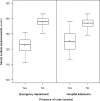Validity of the International Classification of Diseases 10th revision code for hospitalisation with hyponatraemia in elderly patients
- PMID: 23274673
- PMCID: PMC4398982
- DOI: 10.1136/bmjopen-2012-001727
Validity of the International Classification of Diseases 10th revision code for hospitalisation with hyponatraemia in elderly patients
Abstract
Objective: To evaluate the validity of the International Classification of Diseases, 10th Revision (ICD-10) diagnosis code for hyponatraemia (E87.1) in two settings: at presentation to the emergency department and at hospital admission.
Design: Population-based retrospective validation study.
Setting: Twelve hospitals in Southwestern Ontario, Canada, from 2003 to 2010.
Participants: Patients aged 66 years and older with serum sodium laboratory measurements at presentation to the emergency department (n=64 581) and at hospital admission (n=64 499).
Main outcome measures: Sensitivity, specificity, positive predictive value and negative predictive value comparing various ICD-10 diagnostic coding algorithms for hyponatraemia to serum sodium laboratory measurements (reference standard). Median serum sodium values comparing patients who were code positive and code negative for hyponatraemia.
Results: The sensitivity of hyponatraemia (defined by a serum sodium ≤132 mmol/l) for the best-performing ICD-10 coding algorithm was 7.5% at presentation to the emergency department (95% CI 7.0% to 8.2%) and 10.6% at hospital admission (95% CI 9.9% to 11.2%). Both specificities were greater than 99%. In the two settings, the positive predictive values were 96.4% (95% CI 94.6% to 97.6%) and 82.3% (95% CI 80.0% to 84.4%), while the negative predictive values were 89.2% (95% CI 89.0% to 89.5%) and 87.1% (95% CI 86.8% to 87.4%). In patients who were code positive for hyponatraemia, the median (IQR) serum sodium measurements were 123 (119-126) mmol/l and 125 (120-130) mmol/l in the two settings. In code negative patients, the measurements were 138 (136-140) mmol/l and 137 (135-139) mmol/l.
Conclusions: The ICD-10 diagnostic code for hyponatraemia differentiates between two groups of patients with distinct serum sodium measurements at both presentation to the emergency department and at hospital admission. However, these codes underestimate the true incidence of hyponatraemia due to low sensitivity.
Figures

Similar articles
-
Validity of the International Classification of Diseases, 10th revision discharge diagnosis codes for hyponatraemia in the Danish National Registry of Patients.BMJ Open. 2014 Apr 23;4(4):e004956. doi: 10.1136/bmjopen-2014-004956. BMJ Open. 2014. PMID: 24760354 Free PMC article.
-
Validity of the International Classification of Diseases 10th revision code for hyperkalaemia in elderly patients at presentation to an emergency department and at hospital admission.BMJ Open. 2012 Dec 28;2(6):e002011. doi: 10.1136/bmjopen-2012-002011. Print 2012. BMJ Open. 2012. PMID: 23274674 Free PMC article.
-
Validity of the International Classification of Diseases, Tenth Revision code for acute kidney injury in elderly patients at presentation to the emergency department and at hospital admission.BMJ Open. 2012 Nov 29;2(6):e001821. doi: 10.1136/bmjopen-2012-001821. Print 2012. BMJ Open. 2012. PMID: 23204077 Free PMC article.
-
Hyponatraemia in elderly emergency department patients: a marker of frailty.Neth J Med. 2014 Jul;72(6):311-7. Neth J Med. 2014. PMID: 25319856
-
Positive Predictive Values of International Classification of Diseases, 10th Revision Coding Algorithms to Identify Patients With Autosomal Dominant Polycystic Kidney Disease.Can J Kidney Health Dis. 2016 Dec 14;3:2054358116679130. doi: 10.1177/2054358116679130. eCollection 2016. Can J Kidney Health Dis. 2016. PMID: 28781884 Free PMC article.
Cited by
-
Detecting chronic kidney disease in population-based administrative databases using an algorithm of hospital encounter and physician claim codes.BMC Nephrol. 2013 Apr 5;14:81. doi: 10.1186/1471-2369-14-81. BMC Nephrol. 2013. PMID: 23560464 Free PMC article.
-
Identifying geographical regions serviced by hospitals to assess laboratory-based outcomes.BMJ Open. 2013 Jan 3;3(1):e001921. doi: 10.1136/bmjopen-2012-001921. BMJ Open. 2013. PMID: 23293246 Free PMC article.
-
Validity of physician billing claims to identify deceased organ donors in large healthcare databases.PLoS One. 2013 Aug 14;8(8):e70825. doi: 10.1371/journal.pone.0070825. eCollection 2013. PLoS One. 2013. PMID: 23967114 Free PMC article.
-
Identifying Ontario geographic regions to assess adults who present to hospital with laboratory-defined conditions: a descriptive study.CMAJ Open. 2019 Oct 22;7(4):E624-E629. doi: 10.9778/cmajo.20190065. Print 2019 Oct-Dec. CMAJ Open. 2019. PMID: 31641060 Free PMC article.
-
Validity of the International Classification of Diseases, 10th revision discharge diagnosis codes for hyponatraemia in the Danish National Registry of Patients.BMJ Open. 2014 Apr 23;4(4):e004956. doi: 10.1136/bmjopen-2014-004956. BMJ Open. 2014. PMID: 24760354 Free PMC article.
References
-
- Hennessy S. Use of health care databases in pharmacoepidemiology. Basic Clin Pharmacol Toxicol 2006;98:311–13. - PubMed
-
- Suissa S, Garbe E. Primer: administrative health databases in observational studies of drug effects—advantages and disadvantages. Nat Clin Pract Rheumatol 2007;3:725–32. - PubMed
-
- Palmer BF, Gates JR, Lader M. Causes and management of hyponatremia. Ann Pharmacother 2003;37:1694–702. - PubMed
-
- Upadhyay A, Jaber BL, Madias NE. Incidence and prevalence of hyponatremia. Am J Med 2006;119:S30–5. - PubMed
LinkOut - more resources
Full Text Sources
